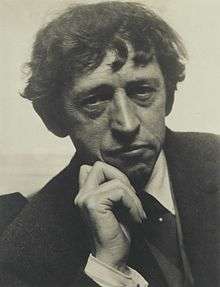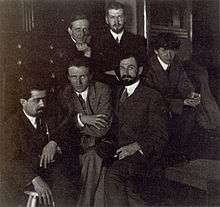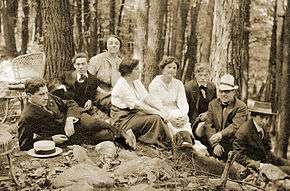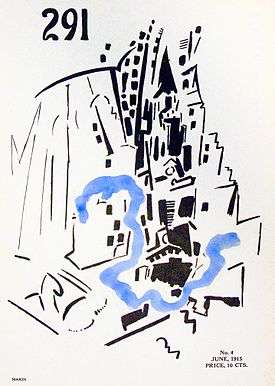John Marin
John Marin (December 23, 1870 – October 2, 1953) was an early American modernist artist. He is known for his abstract landscapes and watercolors.
John Marin | |
|---|---|
 John Marin in 1922 | |
| Born | December 23, 1870 |
| Died | October 1, 1953 (aged 82) |
| Nationality | American |
| Education | Pennsylvania Academy of the Fine Arts |
| Known for | Modern art |
Biography
Marin was born in Rutherford, New Jersey.[1] His mother died nine days after his birth, and he was raised by two aunts in Weehawken, New Jersey.[2] He attended the Stevens Institute of Technology for a year, and tried unsuccessfully to become an architect.[2]


From 1899 to 1901, Marin attended the Pennsylvania Academy of the Fine Arts in Philadelphia. In Philadelphia he studied with Thomas Pollock Anshutz, Hugh Henry Breckenridge and William Merritt Chase. He also studied at the Art Students League of New York.[3] In 1905, like many American artists Marin went to Europe, initially to Paris.[4] He exhibited his work in the Salon, where he also got his first exposure to modern art.[3] He traveled through Europe for six years, and painted in the Netherlands, Belgium, England, and Italy. In Europe, he mastered a type of watercolor where he achieved an abstract ambience, almost a pure abstraction with color that ranges from transparency to translucency, accompanied by strong opacities, and linear elements, always with a sense of freedom, which became one of his trademarks.
In 1909, Marin held his first one-man exhibition at Alfred Stieglitz's 291 gallery in New York City. He had been introduced to Stieglitz by the photographer Edward Steichen, whom Marin in turn had met through the painter Arthur B. Carles. Marin's association with Stieglitz would last nearly forty years, and Stieglitz's philosophical and financial support would prove essential.[5] From 1909 until his death in 1946, Stieglitz showed Marin's work almost every year in one of his galleries.[6] Marin also participated in the landmark 1913 Armory Show.[3]
Marin spent his first summer in Maine in 1914 and almost immediately the rocky coast there became one of his favorite subjects. Over the rest of his life, Marin became intimately familiar with the many moods of the sea and sky in Maine.[6] "In painting water make the hand move the way the water moves," Marin wrote in a 1933 letter to an admirer of his technique.[7]

Marin had a retrospective show in 1936 at the Museum of Modern Art. Late in life Marin achieved tremendous prestige as an American painter, an elder statesman of American art. In 1950, he was honored by the University of Maine and Yale University with honorary degrees of Doctor of Fine Arts.
Marin was a resident of Cliffside Park, New Jersey in his last years, and also maintained a summer home in Addison, Maine, where he died in 1953.[8] He was interred at Fairview Cemetery (Fairview, New Jersey).
Works
John Marin was among the first American artists to make abstract paintings.[9] Marin is often credited with influencing the Abstract Expressionists. His treatment of paint—handling oils almost like watercolors—his forays into abstraction, and his use of evocative stretches of bare canvas caught the eye of younger painters.[10] His experience with architecture might have contributed to the role played by architectural themes in his paintings and watercolors.
The largest collection of Marin's paintings, watercolors, drawings, etchings, and photographs are at the Colby College Museum of Art, the John Marin Collection, given to the college by John Marin Jr. and Norma B. Marin. Marin's paintings are also represented in several important permanent collections and museums including: the Metropolitan Museum of Art, the Museum of Modern Art, the San Francisco Museum of Modern Art, the Whitney Museum of American Art, the Brooklyn Museum, the Cleveland Museum of Art, the Art Institute of Chicago, the National Gallery of Art and The Phillips Collection, both in Washington, D.C., the Fogg Art Museum, Cambridge, Massachusetts, and many others. The White House acquired his 1952 painting "The Circus No. 1" in 2007, and it is now displayed in the Green Room. The artist's Estate is represented by Menconi + Schoelkopf Fine Art, LLC, in New York City.[11]
References
- Johnson, Ken (December 25, 1998), "Art Review: A Restless Explorer of Early Abstraction", The New York Times.
- "Out of the Dark Room", Time, March 16, 1962.
- Roberts, Norma J., ed. (1988), The American Collections, Columbus Museum of Art, p. 84, ISBN 0-8109-1811-0.
- Esplund, Lance (February 5, 2011), "Of Celestial Beings, Sly Foxes and Weehawken", The Wall Street Journal.
- John Marin (1870-1953), Hollis Taggart Galleries, 2007, archived from the original on 2006-08-26.
- Exclusive Representative of the Estate of John Marin, Meredith Ward Fine Art.
- Rosenberg, Karen (December 18, 2008), "John Marin: The Late Oils", The New York Times.
- "John Marin is Dead; Water-colorist, 80; Artist Considered by Many as 'America's No. 1 Master' Succumbs in Maine Home", The New York Times, October 2, 1953, retrieved March 22, 2011.
- Smith, Roberta (February 17, 2011), "John Marin: 'The Weehawken Sequence'", The New York Times.
- Schwendener, Martha (October 26, 2006), "Art in Review: John Marin", The New York Times.
- http://www.msfineart.com
Further reading
- Adelson, Warren; Agee, William C. (2008), Marin: The Late Oils, New York: Adelson Galleries., ISBN 978-0-9815801-1-1
- Balken, Debra Bricker (2011), John Marin: Modernism at Midcentury, New Haven: Yale University Press, ISBN 978-0-300-14993-7.
- Fine, Ruth (1990), John Marin, Washington, D.C.: National Gallery of Art.
- Fine, Ruth (2003), The John Marin Collection at the Colby College Museum of Art, Waterville: Colby College Museum of Art, ISBN 0-9728484-0-1.
- Gray, Cleve, ed. (1970), John Marin by John Marin, New York: Holt, Rinehart and Winston.
- Harnsberger, R. Scott (2002), Four Artists of the Stieglitz Circle: A Sourcebook on Arthur Dove, Marsden Hartley, John Marin, and Max Weber, Westport, CT: Greenwood Press, ISBN 0-313-31488-8.
- Kertess, Klaus (1987), Marin in Oil, Southampton, NY: Parrish Art Museum.
- Marin, John (1949), Selected Writings, New York: Pellegrini & Cudahy.
- Museum of Modern Art (1936), John Marin: Watercolors, Oil Paintings, Etchings, New York: Arno Press.
- Reich, Sheldon (1970), John Marin: A Stylistic Analysis and Catalogue Raisonné, Tucson: University of Arizona Press, ISBN 9780816502660.
- Teachout, Terry (August 5, 2011). "How a Great American Painter Vanished From the Critical Scope". Wall Street Journal. New York, NY, USA: News Corporation. 258 (30). ISSN 0099-9660. OCLC 4299067. Retrieved August 14, 2011.
John Marin was once expected to stand among the greatest American painters of the 20th century.
|section=ignored (help) - Tedeschi, Martha; Dahm, Kristi; Fine, Ruth (2011), John Marin's Watercolors: A Medium for Modernism, Chicago: Art Institute of Chicago, ISBN 978-0-300-16637-8.
- Utah Museum of Fine Arts (1969), Reich, Sheldon (ed.), John Marin Drawings, 1886-1951, Salt Lake City: University of Utah Press.
- Wright, Frederick Stallknecht (1955), John Marin Memorial Exhibition, Los Angeles: UCLA Art Galleries.
- Young, John Sacret (2006), John Marin: The Edge of Abstraction, New York: Meredith Ward Fine Art.